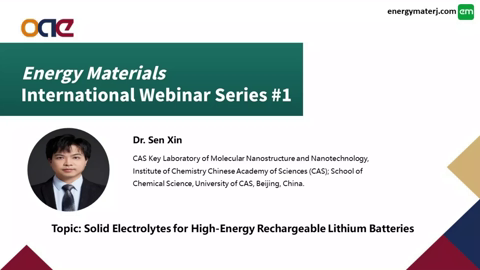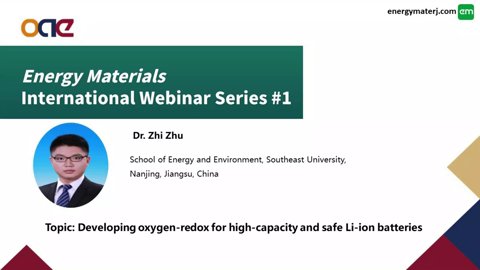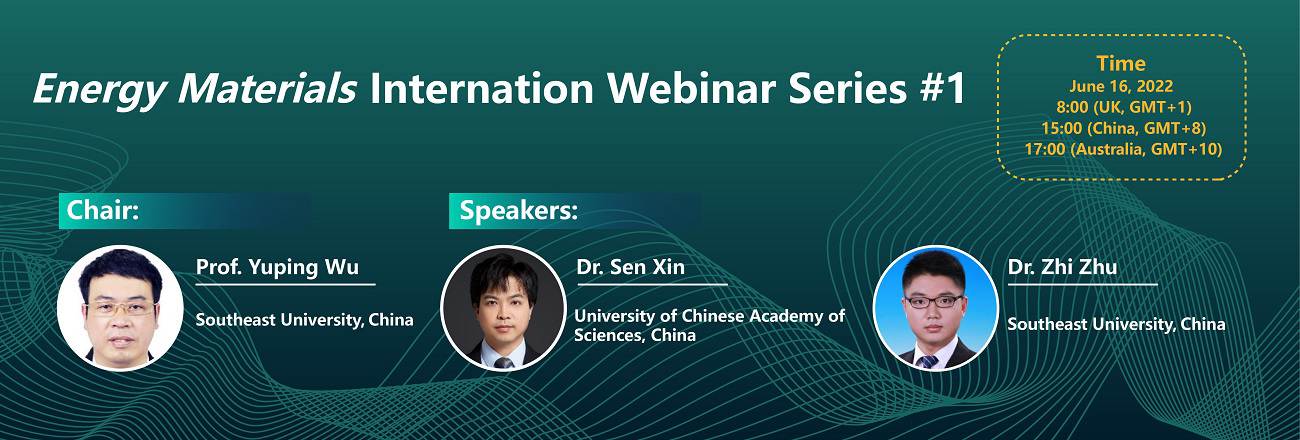Contents
Chair
Yuping Wu
School of Energy and Environment, Southeast University, Nanjing, Jiangsu, China.
Prof. Yuping Wu, Editor-in-Chief of Energy Materials. He is now as professor at School of Energy and Environment (SEU), Southeast University. His current research interests lie in energy storage/conversion materials and devices such as lithium-ion batteries, supercapacitors, aqueous rechargeable lithium batteries, metal-based aqueous batteries, etc.
Prof. Yuping Wu, Editor-in-Chief of Energy Materials. He is now as professor at School of Energy and Environment (SEU), Southeast University. His current research interests lie in energy storage/conversion materials and devices such as lithium-ion batteries, supercapacitors, aqueous rechargeable lithium batteries, metal-based aqueous batteries, etc.
Speaker(s)
Sen Xin
CAS Key Laboratory of Molecular Nanostructure and Nanotechnology, Institute of Chemistry Chinese Academy of Sciences (CAS); School of Chemical Science, University of CAS, Beijing, China.
Professor Sen Xin, Associate Editor of Energy Materials. Prof. Xin is currently an principle investigator at the Institute of Chemistry, Chinese Academy of Sciences. His research interests focus on design and preparation, storage electrochemistry, interfacial chemistry and isotope chemistry of key materials for high-energy rechargeable batteries. He has published 3 book chapters and >130 peer-reviewed papers in Science, Natl. Sci. Rev., Acc. Chem. Res., J. Am. Chem. Soc., Angew. Chem., Sci. China Chem. and Energy Mater., with a total citation of >16,000 times. He was consecutively identified as Highly Cited Researcher by Clarivate Analysis in the years of 2019 to 2021. He was the recipient of Chinese Chemical Society Award for Outstanding Young Chemist (2021), and Young Scholars Award for Electrochemistry in China (2021).
Topic: Solid Electrolytes for High-Energy Rechargeable Lithium Batteries
Abstract: Solid-state rechargeable lithium batteries (SSRLBs) with high specific energy are desired for the next-generation energy storage. Inorganic ceramic oxide electrolytes, such as garnet-type Li7La3Zr2O12, are promising candidates for realizing the SSRLBs. Practically, it is challenging to prepare high-performance thin-film solid electrolyte due to high brittleness of the sintered ceramic pellet, and low Li-ion conductivity of the loosely-packed ceramic powder via conventional tape-casting process. In this talk, we showed that by coating ultrathin conductive polymer on the surface of ceramics powder particles, rapid interparticle Li-ion conduction could be enabled via a facile, sintering-free tape-casting process. Asymmetric thin-film electrolytes were then prepared and showed favorable electrochemical performance for projecting high-energy rechargeable lithium batteries.
Professor Sen Xin, Associate Editor of Energy Materials. Prof. Xin is currently an principle investigator at the Institute of Chemistry, Chinese Academy of Sciences. His research interests focus on design and preparation, storage electrochemistry, interfacial chemistry and isotope chemistry of key materials for high-energy rechargeable batteries. He has published 3 book chapters and >130 peer-reviewed papers in Science, Natl. Sci. Rev., Acc. Chem. Res., J. Am. Chem. Soc., Angew. Chem., Sci. China Chem. and Energy Mater., with a total citation of >16,000 times. He was consecutively identified as Highly Cited Researcher by Clarivate Analysis in the years of 2019 to 2021. He was the recipient of Chinese Chemical Society Award for Outstanding Young Chemist (2021), and Young Scholars Award for Electrochemistry in China (2021).
Topic: Solid Electrolytes for High-Energy Rechargeable Lithium Batteries
Abstract: Solid-state rechargeable lithium batteries (SSRLBs) with high specific energy are desired for the next-generation energy storage. Inorganic ceramic oxide electrolytes, such as garnet-type Li7La3Zr2O12, are promising candidates for realizing the SSRLBs. Practically, it is challenging to prepare high-performance thin-film solid electrolyte due to high brittleness of the sintered ceramic pellet, and low Li-ion conductivity of the loosely-packed ceramic powder via conventional tape-casting process. In this talk, we showed that by coating ultrathin conductive polymer on the surface of ceramics powder particles, rapid interparticle Li-ion conduction could be enabled via a facile, sintering-free tape-casting process. Asymmetric thin-film electrolytes were then prepared and showed favorable electrochemical performance for projecting high-energy rechargeable lithium batteries.
Zhi Zhu
Professor, School of Energy and Environment, Southeast University, Nanjing, Jiangsu, China.
Dr. Zhi Zhu is currently a youth-chair professor at the School of Energy and Environment, Southeast University and granted the 2021 “National High-Level Youth-Talent Program”. He received his PhD degree of chemistry from Peking University and worked at Massachusetts Institute of Technology (MIT) as a Postdoc Associate and Research Scientist. Zhi Zhu’s research is focusing on developing novel cathode materials for high-energy Li ion battery. He proposed a new concept of solid oxygen anion-redox and firstly developed the nanolithia cathode that achieved a super high capacity with pure oxygen anion redox in a sealed battery system. As the first author, he has published 2 papers on Nature Energy, 1 on Energy & Environmental Science, Advanced Materials and Advanced Energy Materials etc.
Topic: Developing oxygen-redox for high-capacity and safe Li-ion batteries
Abstract: All the currently used cathodes for Li ion batteries in market are heavy lithium transition-metal oxides, which have capacity limitations within ~270 mAh/g. To make a substantial breakthrough, we developed a light "ultra-oxygen redox" concept for super high capacity. We designed O2-↔O0.5- redox and developed a composite nanolithia cathode, which owns theoretical-capacity of 1381mAh/g, nearly 5 time that of the current cathodes. We also developed ultra-oxygen redox in other cathodes for higher capacity and defined another new concept of "hybrid ultra-oxygen anion and metal cation redox (HACR)" for such electrochemical behavior involved high-energy cathodes. Additionally, we demonstrated that enabling ultra-oxygen redox but preventing global ultra-oxygen migration is the key to developing high-energy cathodes. Then we established series of new crystal structures to stabilize the ultra-oxygen, so that unprecedented high-energy LXMO and LiCoO2 battery lives have been achieved in prototype pouch full cells.
Dr. Zhi Zhu is currently a youth-chair professor at the School of Energy and Environment, Southeast University and granted the 2021 “National High-Level Youth-Talent Program”. He received his PhD degree of chemistry from Peking University and worked at Massachusetts Institute of Technology (MIT) as a Postdoc Associate and Research Scientist. Zhi Zhu’s research is focusing on developing novel cathode materials for high-energy Li ion battery. He proposed a new concept of solid oxygen anion-redox and firstly developed the nanolithia cathode that achieved a super high capacity with pure oxygen anion redox in a sealed battery system. As the first author, he has published 2 papers on Nature Energy, 1 on Energy & Environmental Science, Advanced Materials and Advanced Energy Materials etc.
Topic: Developing oxygen-redox for high-capacity and safe Li-ion batteries
Abstract: All the currently used cathodes for Li ion batteries in market are heavy lithium transition-metal oxides, which have capacity limitations within ~270 mAh/g. To make a substantial breakthrough, we developed a light "ultra-oxygen redox" concept for super high capacity. We designed O2-↔O0.5- redox and developed a composite nanolithia cathode, which owns theoretical-capacity of 1381mAh/g, nearly 5 time that of the current cathodes. We also developed ultra-oxygen redox in other cathodes for higher capacity and defined another new concept of "hybrid ultra-oxygen anion and metal cation redox (HACR)" for such electrochemical behavior involved high-energy cathodes. Additionally, we demonstrated that enabling ultra-oxygen redox but preventing global ultra-oxygen migration is the key to developing high-energy cathodes. Then we established series of new crystal structures to stabilize the ultra-oxygen, so that unprecedented high-energy LXMO and LiCoO2 battery lives have been achieved in prototype pouch full cells.
Presentation

Dr. Sen Xin
Topic: Solid Electrolytes for High-Energy Rechargeable Lithium Batteries
NaN

Dr. Zhi Zhu
Topic: Developing oxygen-redox for high-capacity and safe Li-ion batteries
NaN







